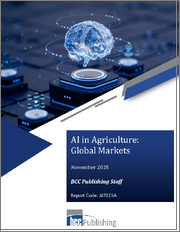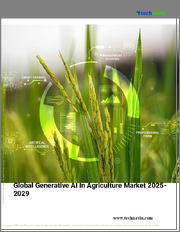
|
시장보고서
상품코드
1605284
농업 분야 인공지능 시장 규모, 점유율, 성장 분석 : 기술별, 제공업체별, 용도별, 전개 방식별, 최종사용자별, 지역별 - 산업 예측(2024-2031년)Artificial Intelligence in Agriculture Market Size, Share, Growth Analysis, By Technology (Machine Learning, Computer Vision), By Offering, By Application, By Deployment Mode, By End User, By Region - Industry Forecast 2024-2031 |
||||||
농업 분야 인공지능 세계 시장 규모는 2022년에 18억 2,000만 달러를 기록했으며, 2023년 22억 3,000만 달러에서 2031년에는 113억 9,000만 달러로 성장하고, 예측기간(2024-2031년) 동안 CAGR은 22.6%로 성장할 전망입니다.
세계 농업 분야 인공지능 시장은 첨단 기술이 농업을 근본적으로 변화시키면서 급성장하고 있습니다. 전 세계 농부들은 작업 효율성과 생산성을 높이기 위해 AI 기반 도구를 도입하고 있습니다. 주요 응용 분야로는 작물 모니터링, 해충 탐지, 수확량 예측 등이 있으며, 실시간 데이터 분석을 통해 정보에 입각한 의사결정을 돕고, 자원 낭비를 최소화하며, 수확량을 증가시키는 실시간 데이터 분석을 통해 AI가 탑재된 드론과 자율 로봇의 사용은 비료와 농약을 정확하게 살포할 수 있게 해줍니다. 비료와 농약의 정확한 살포가 가능하여 작물 관리를 더욱 정교하게 합니다. 또한, AI로 강화된 농기계는 인건비를 줄이면서 생산성을 향상시키고, AI 챗봇과 가상 비서를 통합하여 농부들이 날씨, 시장 동향, 전략 수립에 대한 중요한 인사이트를 얻을 수 있도록 하여 위험 관리를 향상시킬 수 있습니다. 작물 육종과 같은 분야로 확대되면서 보다 탄력적인 식물 품종 개발에 기여하고 있습니다. 그러나 농업 분야에서 AI의 유망한 성장에도 불구하고, 데이터 프라이버시, 높은 도입 비용, 지역별로 불균등한 기술 접근성 등의 문제는 여전히 남아 있습니다. 그럼에도 불구하고, 전 세계 농업 부문이 인공지능의 혁신적 이점을 점점 더 많이 활용하여 보다 지속가능하고 효율적인 농업을 추진할 수 있는 미래는 밝아 보입니다.
목차
소개
- 조사 목적
- 조사 범위
- 정의
조사 방법
- 정보 조달
- 2차 데이터와 1차 데이터 방법
- 시장 규모 예측
- 시장 가정과 제한
주요 요약
- 세계 시장 전망
- 공급과 수요 동향 분석
- 부문별 기회 분석
시장 역학과 전망
- 시장 개요
- 시장 규모
- 시장 역학
- 성장 촉진요인과 기회
- 성장 억제요인과 과제
- Porters 분석과 영향
- 경쟁 기업 간의 경쟁 관계
- 대체품의 위협
- 구매자의 교섭력
- 신규 참여업체의 위협
- 공급 기업의 교섭력
주요 시장 인사이트
- 핵심성공요인
- 경쟁 정도
- 주요 투자 기회
- 시장 생태계
- 시장 매력 지수(2023년)
- PESTEL 분석
- 거시경제 지표
- 밸류체인 분석
- 가격 분석
- 기술의 진보
- 규제 상황
- 특허 분석
- 사례 연구
- 고객과 구매 기준 분석
- 스타트업 분석
농업 분야 인공지능 시장 규모 : 기술별 & CAGR(2024-2031)
- 시장 개요
- 머신러닝
- 지도 학습
- 비지도 학습
- 강화 학습
- 컴퓨터 비전
- 예측 분석
농업 분야 인공지능 시장 규모 : 제공별 & CAGR(2024-2031)
- 시장 개요
- 하드웨어
- 센서
- 드론
- 카메라
- 소프트웨어
- AI 플랫폼
- AI 솔루션
- 서비스
- 전문 서비스
- 매니지드 서비스
농업 분야 인공지능 시장 규모 : 용도별 & CAGR(2024-2031)
- 시장 개요
- 정밀 농업
- 수확량 모니터링
- 필드 매핑
- 작물 스카우팅
- 가축 모니터링
- 건강 모니터링
- 행동 감시
- 드론 분석
- 작물 건강 모니터링
- 토양 건강 모니터링
- 농업 로봇
- 수확 로봇
- 제초 로봇
- 기타
- 일기예보
- 관개 관리
농업 분야 인공지능 시장 규모 : 전개 방식별 & CAGR(2024-2031)
- 시장 개요
- 클라우드
- 온프레미스
- 하이브리드
농업 분야 인공지능 시장 규모 : 최종사용자별 & CAGR(2024-2031)
- 시장 개요
- 농가
- 농업 기업
- 연구기관
- 정부기관
농업 분야 인공지능 시장 규모 : 지역별 & CAGR(2024-2031)
- 북미
- 미국
- 캐나다
- 유럽
- 영국
- 독일
- 스페인
- 프랑스
- 이탈리아
- 기타 유럽
- 아시아태평양
- 중국
- 인도
- 일본
- 한국
- 기타 아시아태평양
- 라틴아메리카
- 브라질
- 기타 라틴아메리카
- 중동 및 아프리카
- GCC 국가
- 남아프리카공화국
- 기타 중동 및 아프리카
경쟁 정보
- 상위 5개사의 비교
- 주요 기업의 시장 포지셔닝(2023년)
- 주요 시장 기업이 채용한 전략
- 시장의 최근 동향
- 기업의 시장 점유율 분석(2023년)
- 주요 기업 개요
- 기업 개요
- 제품 포트폴리오 분석
- 부문별 점유율 분석
- 매출 전년비 비교(2021-2023)
주요 기업 개요
- IBM Corporation
- Microsoft Corporation
- Deere & Company
- Granular Inc.
- aWhere Inc.
- Prospera Technologies Ltd.
- Taranis
- Agribotix LLC
- The Climate Corporation
- Descartes Labs, Inc.
- Mavrx Inc.
- Gamaya
- PrecisionHawk
- Cainthus
- Farmers Edge Inc.
- Resson Aerospace Corporation
- Connecterra B.V.
- Vision Robotics Corporation
- Harvest CROO Robotics
- AgEagle Aerial Systems Inc.
결론과 추천사항
ksm 24.12.16Global Artificial Intelligence in Agriculture Market size was valued at USD 1.82 billion in 2022 and is poised to grow from USD 2.23 billion in 2023 to USD 11.39 billion by 2031, growing at a CAGR of 22.6% during the forecast period (2024-2031).
The Global Artificial Intelligence in Agriculture Market is witnessing significant growth, fundamentally transforming farming through advanced technologies. Farmers around the world are increasingly adopting AI-driven tools to enhance operational efficiency and production capabilities. Key applications include crop monitoring, pest detection, and yield forecasting, facilitated by real-time data analytics that support informed decision-making, minimize resource waste, and boost yields. The use of drones and autonomous robots with integrated AI further refines crop management by allowing for precise application of fertilizers and pesticides. Moreover, AI-enhanced agricultural machinery improves productivity while reducing labor costs. The incorporation of AI chatbots and virtual assistants provides farmers with crucial insights into weather, market trends, and strategic planning, thus improving risk management. As AI applications expand into areas like genomics and crop breeding, they contribute to developing more resilient plant varieties. However, despite the promising growth of AI in agriculture, challenges such as data privacy, high implementation costs, and uneven access to tech persist across regions. Nonetheless, the future appears bright for the global agriculture sector as it increasingly leverages the transformative benefits of artificial intelligence, driving toward more sustainable and efficient farming practices.
Top-down and bottom-up approaches were used to estimate and validate the size of the Global Artificial Intelligence In Agriculture market and to estimate the size of various other dependent submarkets. The research methodology used to estimate the market size includes the following details: The key players in the market were identified through secondary research, and their market shares in the respective regions were determined through primary and secondary research. This entire procedure includes the study of the annual and financial reports of the top market players and extensive interviews for key insights from industry leaders such as CEOs, VPs, directors, and marketing executives. All percentage shares split, and breakdowns were determined using secondary sources and verified through Primary sources. All possible parameters that affect the markets covered in this research study have been accounted for, viewed in extensive detail, verified through primary research, and analyzed to get the final quantitative and qualitative data.
Global Artificial Intelligence In Agriculture Market Segmental Analysis
Global Artificial Intelligence in Agriculture Market is segmented by technology, offering, application, deployment mode, end user and region. Based on technology, the market is segmented into machine learning (supervised learning, unsupervised learning, reinforcement learning), computer vision and predictive analytics. Based on offering, the market is segmented into hardware (sensors, drones, cameras), software (AI platforms, AI solutions) and services (professional services, managed services). Based on application, the market is segmented into precision farming (yield monitoring, field mapping, crop scouting), livestock monitoring (health monitoring, behaviour monitoring), drone analytics (crop health monitoring, soil health monitoring), agricultural robots (harvesting robots, weeding robots) and others (weather forecasting, irrigation management). Based on deployment mode, the market is segmented into cloud, on-premises and hybrid. Based on end user, the market is segmented into farmers, agricultural corporations, research institutions and government agencies. Based on region, the market is segmented into North America, Europe, Asia Pacific, Latin America and Middle East & and Africa.
Driver of the Global Artificial Intelligence In Agriculture Market
A significant factor driving the Global Artificial Intelligence in Agriculture Market is the escalating demand for sustainable and efficient farming methods. With the global population on the rise, the need for increased food production intensifies, compelling the agricultural sector to enhance productivity while conserving resources. AI-driven technologies present innovative solutions that optimize various agricultural processes, including precision farming and systematic decision-making based on data analysis. This shift towards the adoption of AI is becoming essential for farmers and agricultural organizations, as they strive to address the dual challenges of food security and environmental sustainability effectively.
Restraints in the Global Artificial Intelligence In Agriculture Market
A significant challenge facing the Global Artificial Intelligence in Agriculture Market is the high initial implementation cost. The adoption of AI technologies demands a considerable investment in hardware, software, and associated services. Moreover, the necessity of training personnel and upgrading existing infrastructure to integrate AI solutions can impose a heavy financial burden, particularly for smaller and less resourceful farmers. This cost barrier often limits the overall adoption of AI in agricultural practices and, in turn, restrains market growth. To effectively address this issue, it is essential to develop affordable AI solutions, provide accessible financing alternatives, and introduce government incentives to promote broader acceptance of AI within the agricultural sector.
Market Trends of the Global Artificial Intelligence In Agriculture Market
The Global Artificial Intelligence in Agriculture market is witnessing a notable trend characterized by the rising adoption of digital farming platforms. Agricultural stakeholders, including farmers and organizations, are increasingly leveraging AI-powered platforms that deliver holistic solutions for crop management, data analytics, and informed decision-making. These innovative platforms harness diverse AI technologies, such as machine learning, satellite imagery, and IoT sensors, facilitating real-time insights and optimization of agricultural practices. This trend signifies a transformative shift in the industry towards data-centric and technology-enabled methodologies aimed at enhancing productivity, sustainability, and profitability, ultimately reshaping the future of agriculture.
Table of Contents
Introduction
- Objectives of the Study
- Scope of the Report
- Definitions
Research Methodology
- Information Procurement
- Secondary & Primary Data Methods
- Market Size Estimation
- Market Assumptions & Limitations
Executive Summary
- Global Market Outlook
- Supply & Demand Trend Analysis
- Segmental Opportunity Analysis
Market Dynamics & Outlook
- Market Overview
- Market Size
- Market Dynamics
- Driver & Opportunities
- Restraints & Challenges
- Porters Analysis & Impact
- Competitive rivalry
- Threat of substitute
- Bargaining power of buyers
- Threat of new entrants
- Bargaining power of suppliers
Key Market Insights
- Key Success Factors
- Degree of Competition
- Top Investment Pockets
- Market Ecosystem
- Market Attractiveness Index, 2023
- PESTEL Analysis
- Macro-Economic Indicators
- Value Chain Analysis
- Pricing Analysis
- Technological Advancement
- Regulatory Landscape
- Patent Analysis
- Case Studies
- Customer & Buying Criteria Analysis
- Startup Analysis
Global Artificial Intelligence in Agriculture Market Size by Technology & CAGR (2024-2031)
- Market Overview
- Machine Learning
- Supervised Learning
- Unsupervised Learning
- Reinforcement Learning
- Computer Vision
- Predictive Analytics
Global Artificial Intelligence in Agriculture Market Size by Offering & CAGR (2024-2031)
- Market Overview
- Hardware
- Sensors
- Drones
- Cameras
- Software
- AI Platforms
- AI Solutions
- Services
- Professional Services
- Managed Services
Global Artificial Intelligence in Agriculture Market Size by Application & CAGR (2024-2031)
- Market Overview
- Precision Farming
- Yield Monitoring
- Field Mapping
- Crop Scouting
- Livestock Monitoring
- Health Monitoring
- Behaviour Monitoring
- Drone Analytics
- Crop Health Monitoring
- Soil Health Monitoring
- Agricultural Robots
- Harvesting Robots
- Weeding Robots
- Others
- Weather Forecasting
- Irrigation Management
Global Artificial Intelligence in Agriculture Market Size by Deployment Mode & CAGR (2024-2031)
- Market Overview
- Cloud
- On-Premises
- Hybrid
Global Artificial Intelligence in Agriculture Market Size by End User & CAGR (2024-2031)
- Market Overview
- Farmers
- Agricultural Corporations
- Research Institutions
- Government Agencies
Global Artificial Intelligence in Agriculture Market Size & CAGR (2024-2031)
- North America, (Technology, Offering, Application, Deployment Mode, End User)
- US
- Canada
- Europe, (Technology, Offering, Application, Deployment Mode, End User)
- UK
- Germany
- Spain
- France
- Italy
- Rest of Europe
- Asia-Pacific, (Technology, Offering, Application, Deployment Mode, End User)
- China
- India
- Japan
- South Korea
- Rest of Asia Pacific
- Latin America, (Technology, Offering, Application, Deployment Mode, End User)
- Brazil
- Rest of Latin America
- Middle East & Africa, (Technology, Offering, Application, Deployment Mode, End User)
- GCC Countries
- South Africa
- Rest of Middle East & Africa
Competitive Intelligence
- Top 5 Player Comparison
- Market Positioning of Key Players, 2023
- Strategies Adopted by Key Market Players
- Recent Developments in the Market
- Company Market Share Analysis, 2023
- Company Profiles of All Key Players
- Company Details
- Product Portfolio Analysis
- Company's Segmental Share Analysis
- Revenue Y-O-Y Comparison (2021-2023)
Key Company Profiles
- IBM Corporation
- Company Overview
- Business Segment Overview
- Financial Updates
- Key Developments
- Microsoft Corporation
- Company Overview
- Business Segment Overview
- Financial Updates
- Key Developments
- Deere & Company
- Company Overview
- Business Segment Overview
- Financial Updates
- Key Developments
- Granular Inc.
- Company Overview
- Business Segment Overview
- Financial Updates
- Key Developments
- aWhere Inc.
- Company Overview
- Business Segment Overview
- Financial Updates
- Key Developments
- Prospera Technologies Ltd.
- Company Overview
- Business Segment Overview
- Financial Updates
- Key Developments
- Taranis
- Company Overview
- Business Segment Overview
- Financial Updates
- Key Developments
- Agribotix LLC
- Company Overview
- Business Segment Overview
- Financial Updates
- Key Developments
- The Climate Corporation
- Company Overview
- Business Segment Overview
- Financial Updates
- Key Developments
- Descartes Labs, Inc.
- Company Overview
- Business Segment Overview
- Financial Updates
- Key Developments
- Mavrx Inc.
- Company Overview
- Business Segment Overview
- Financial Updates
- Key Developments
- Gamaya
- Company Overview
- Business Segment Overview
- Financial Updates
- Key Developments
- PrecisionHawk
- Company Overview
- Business Segment Overview
- Financial Updates
- Key Developments
- Cainthus
- Company Overview
- Business Segment Overview
- Financial Updates
- Key Developments
- Farmers Edge Inc.
- Company Overview
- Business Segment Overview
- Financial Updates
- Key Developments
- Resson Aerospace Corporation
- Company Overview
- Business Segment Overview
- Financial Updates
- Key Developments
- Connecterra B.V.
- Company Overview
- Business Segment Overview
- Financial Updates
- Key Developments
- Vision Robotics Corporation
- Company Overview
- Business Segment Overview
- Financial Updates
- Key Developments
- Harvest CROO Robotics
- Company Overview
- Business Segment Overview
- Financial Updates
- Key Developments
- AgEagle Aerial Systems Inc.
- Company Overview
- Business Segment Overview
- Financial Updates
- Key Developments



















